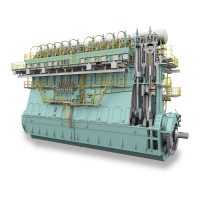Operation0710−1/A1
Winterthur Gas & Diesel Ltd.
8/ 12
3.11.2 Aluminum and Silicon
Aluminum (Al) and silicon (Si) in the fuel are an indication of catalytic fines (cat fines).
These are particles of hard oxides (round particles of material almost the same as
porcelain) which cause high abrasive wear to pistons, piston rings and cylinder liners.
Cat fines are used as a catalyst in some processes in petroleum refining and can be
found in diesel engine fuels. The most dangerous cat fines are between 10 microns
and 20 microns.
Cat fines are attracted to water droplets and are very difficult to remove from the fuel.
With correct treatment in the fuel separator, the aluminium and silicon content of
60 ppm (mg/kg) can be decreased to 15 ppm (mg/kg), which is thought to be
satisfactory. For satisfactory separation, a fuel temperature as close as possible to
98_C is recommended. If there are more than 40 ppm cat fines in the bunkered fuel, a
decreased flow rate in the separator is recommended. Also, the instructions of the
equipment manufacturer must be obeyed.
Cat fines can collect in the sediment of the fuel tank from other bunkers. During bad
weather conditions, the movement of the ship mixes the sediment into the fuel. Thus,
it is better to think that all fuels contain cat fines, although it is possible that a fuel
analysis can show a different result. This makes continuous and satisfactory
separation very important.
Note: The Al+Si limit in the new ISO 8217:2010 specification is decreased to
60 mg/kg for the RMG and RMK grades.
3.12 Used Lubricating Oil and Chemical Waste
Used lubricating oils and chemical waste must not be mixed into the fuel pool. If used
lubricating oil is mixed in, fuel is not stable because the base oil is very paraffinic and
can cause too much sludge. Most used lubricating oil is from the crankcase, thus
sufficiently large quantities of calcium, zinc, phosphorous and other additives and
wear metals can cause contamination. The limits in ISO 8217: 2010 and the
Winterthur Gas & Diesel Ltd. specification make sure that no used lubricating oil is in
the fuel. This is related to the limits of the test methods used to find the levels of these
metals, which can occur naturally in the fuel.
Chemical waste must not be added to the fuel. There were some examples of
polymers, styrene and other chemical substances found in fuel. These materials can
cause the fuel to become too thick, to become almost solid and block filters. They can
also cause damage to fuel injection systems and cause fuel pump plungers and
injectors to stop.
2016-11
Diesel Engine Fuels

